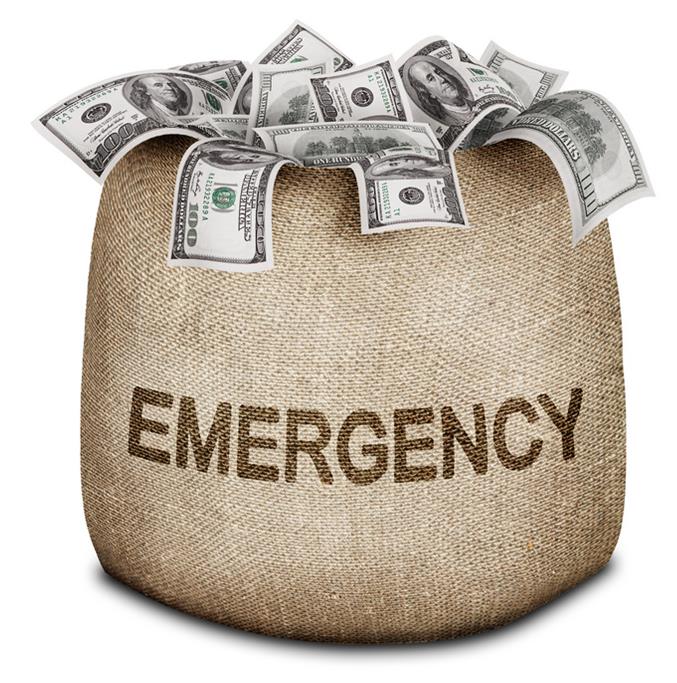Emergency Fund: Better Safe Than Sorry!
Halloween is a time for delighting in all that is spooky or scary. However, when it comes to financial emergencies, we're all likely to jump out of our skin with fear if we don't have a plan for how to pay up. Rather than putting on a mask, pretending that you would be fine if an unexpected expense arose, planning ahead is better for your wallet and for your peace of mind. Saving for an emergency fund over time is a great way to do this!
What's an Emergency Fund?
An emergency fund is a sum of saved money that is readily available to be used for an unexpected expense. According to NerdWallet, many people prioritize other things over these funds, but they can actually afford you security and flexibility in your future spending.
An emergency fund or "rainy day fund" isn't for vacations or luxuries, but rather to keep you from having to go into debt when you encounter a surprise or emergency. Most of us allocate every penny of the paycheck, so an emergency fund gives breathing room for life's surprises. These funds are used for the big, tough moments in life: job loss, broken-down cars, or a surprise medical bill.
Emergency funds are different from long-term savings like Certificates or retirement accounts. An important part of these funds is that you can access them fast, usually in a savings or money market account that allows for fee-free withdrawals.
Why Have an Emergency Fund?

While there are many reasons that an emergency fund is a good idea, here are a few that tend to get people excited to save a little more:
- If a car expense, home expense, or medical bill shows up that you aren't expecting, you want to be able to pay for it without going into further debt. For instance, paying for such bills out of your emergency fund is in effect "free," while paying with a credit card comes with the fee of however much interest accrues before you pay it back.
- Having an emergency fund, even if you never touch it, gives you a sense of well-being and comfort, knowing that if something tough happened, you'd have that money available.
- Most emergency funds can be kept in interest-yielding accounts, like a savings account or money market account. This means you can actually earn money on the money that becomes your "Rainy Day Fund" if something unexpected happens.
- Once you get in the habit of saving for an Emergency Fund, you may find that there are other ways to be intentional with your money. Once your fund is "full," you can start investing that same amount of money in your retirement accounts or other investments.
How Big Should My Emergency Fund Be?
The best size of an emergency fund, to start out, is anything; the more you have saved in liquid form, the easier it is to weather a difficult financial storm. However, the general aim, according to Forbes, is to have 3-6 months of your expenses saved. This will vary wildly, from a single, healthy individual with inexpensive housing to a large family juggling debts and medical expenses, but aiming for this level of emergency fund is logical. By having this much saved, if you lose a major source of income, you can weather the storm for quite a few weeks without using credit cards or other short-term debt.
That being said, people start reaping the rewards of having an emergency fund even after they only have a few extra dollars saved. However, the hard part can sometimes be leaving that money alone during the hard first few months of saving: when your Emergency Fund is small, resist the temptation to clear it out for non-emergency circumstances. The future version of you will be glad you did!
How to Start Saving For an Emergency Fund?

There are many ways to save for an emergency fund, but the most important goal of this savings process is to make painless and sometimes even automatic savings part of your life. It's hard to miss money you don't have.
- If you can manage it, make a small automatic transfer from your checking account to your savings account for two or three days after your paycheck arrives. This means that the money disappears when you have the most of it, and you budget accordingly for the rest of the month.
- Play the "One Less" game, and see if you can do with one less of something you currently buy. Obviously there are necessities for which this cannot work, but around Halloween, for instance, you can ask, "Can I live with one less bag of candy? One less pumpkin on the front porch? One less accessory for my costume?"
- Start budgeting or look at the budget you currently have. By making limits on any given element of your spending, it becomes harder to overspend accidentally, which means that there is more likelihood to be money leftover for saving. This is especially helpful if you usually find that you are running short of money at the end of the pay period.
Places to Keep Your Emergency Fund
While the most common place to put an Emergency Fund is in a savings account that can easily be transferred to checking, there are other options. If you know that it will help you save to start out with cash, start filling a piggy bank! Getting excited about saving is a big part of the process.
If you have a Roth Individual Retirement Account (IRA), you can actually withdraw the principal (initial investment, not the interest you earn) without a penalty, so that can be a nice way to invest in your retirement future while still giving yourself the option of using some of that money. Keep in mind, however, that Roth IRAs can technically lose value if the market suffers, so it's good to have at least a substantial part of your money in an account where your initial investment is secured.
These strategies can work whether you are trying to get up to a few hundred dollars or a few thousand; at every stage, an emergency fund makes it easier to weather the ordinary surprises of life, as well as the more extraordinary ones. Don't let saving for a rainy day spook you into spending everything you earn; starting an emergency fund is as easy as setting aside that first dollar.
